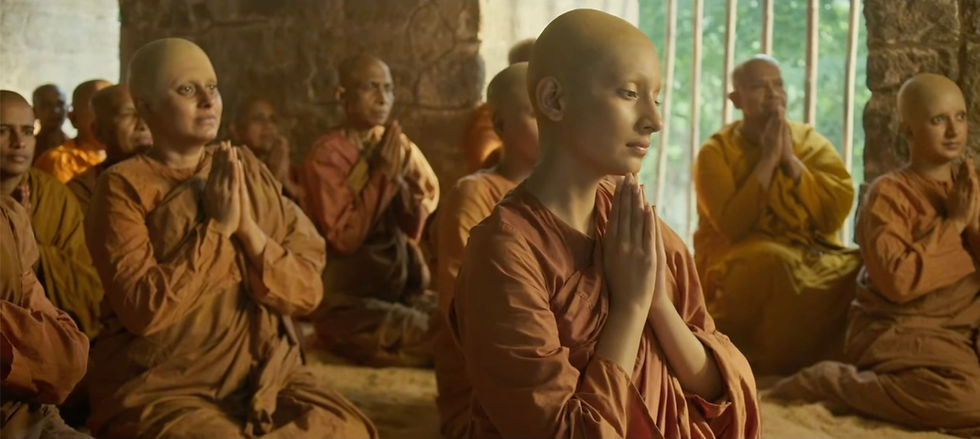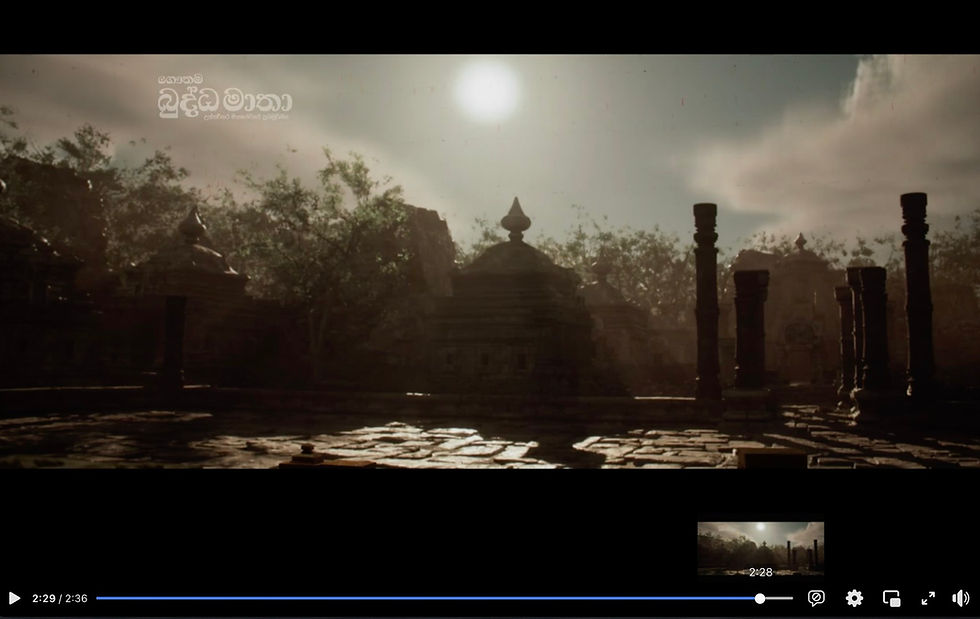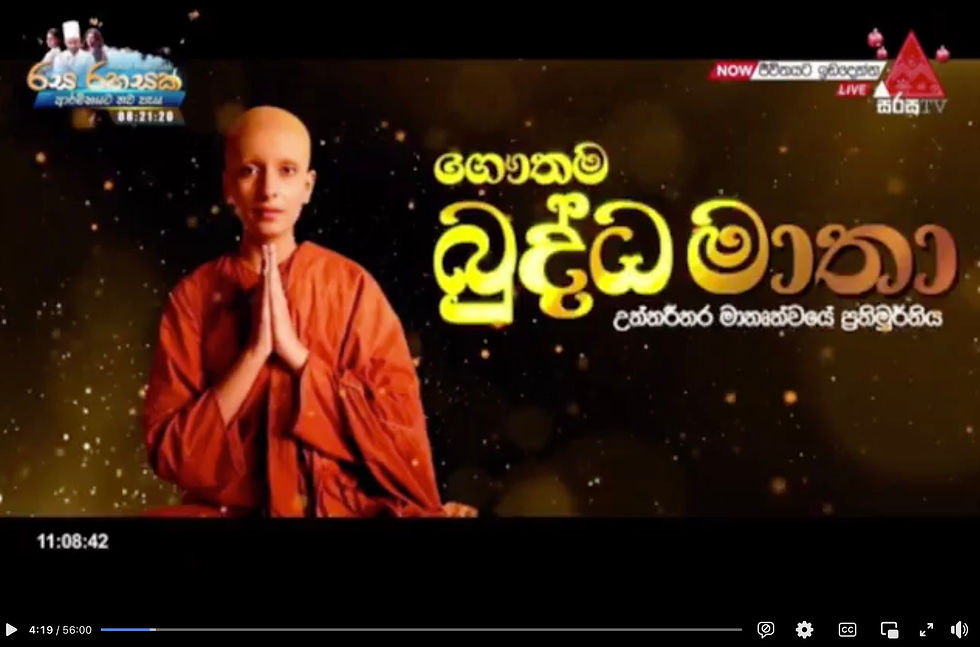Tathālokā Therī
January 24, 2025

It was a surprise around this past December full moon, a time when the highly revered great bhikkhunī arahant Sanghamittā Therī is normally the focus of remembrance and veneration in Sri Lankan Buddhism, to see the release of the new movie "Gautama Buddha Matha" "ගෞතම බුද්ධ මාතා", on the life of Mahāpajāpatī Gotamī. We now see limited release in Australia on January 20th 2025.
I initially learned about this new movie from an email alert to my Gmail for mainstream media publications mentioning "bhikkhuni". What was the alert?
"A timely film ‘Gautama Buddha Matha’, reminds us to stand up for the rights of bhikkhunis"
"The release of the historical film ‘Gautama Buddha Matha’ on the life of the much revered Prajapathi Gothami Maha Theri in the month of Uduvap poya [the December full moon] is of much significance to Buddhists. It was on Sangamitta Day that the sacred Bo Sapling was brought to Ceylon by Ven. SangamittaTheri and the Bhikkhuni Sasana was established in the country during King Devanampiyatissa’s reign..."
I did a Google search for "Gautama Buddha Matha" to learn more and read further with increasing interest:
"Based on and inspired by Faxian, this film on the life of Mahapajapati Gotami is being released in Sri Lanka today on the Unduvap Poya (Margashirsh Purnima), on a day normally reserved for honoring Sanghamitta Theri.
"The plot (in English), in which the Stupa of Mahapajapati Gotami Theri figures prominent:"

Last words of the plot summary:
"The travelers, Fa Hien [Faxian 法顯] and Hiuen Tsang [Xuanzang 玄奘] pay homage to that stupa built in the 6th century BC. Creative concept and production: Thilanga Sumathipala The script and Direction: Emeritus Professor Sunil Ariyaratne."

Dharma Master Bhikkhu Faxian 東晉法顯大師 (also Romanized: Fa Xian, Fa-Hien, Fa-hsien, Fǎxiǎn), travelled to India and Sri Lanka as a pilgrim, in search of Vinaya texts to bring back to the Sangha in China, in the 5th century CE.
Both he and another even more famous Chinese pilgrim of the 7th century, Xuanzang 玄奘大師/玄奘三藏 (also Romanized in many different ways including Hsüan-tsang), observed and recorded the stupa of one of the first if not the first Buddhist bhikkhunī, the Buddha's maternal aunt and foster mother, and later foremost leading arahanta, Mahāpajāpatī Gotamī Therī.

Master Faxian, upon traveling to Sri Lanka and staying in the international Abhayagiri Monastery in Anuradhapura, observed a great number of inspiring bhikkhunīs there, and made efforts to introduce their Vinaya tradition and ordination lineage into China.
At that time, the great Abhayagirivihāraya of Anuradhapura was flourishing with royal patronage, and appears to have incorporated many of the historically important early bhikkhunī sites in the Anuradhapura and Mihintale areas. These appear to have included Indian bhikkhunī arahant Sanghamittā Therī's retreat on the Kadamba Nādi (Malwattu Oya) River, and first Sri Lankan bhikkhunī arahant Anula Tissa Therī's stupa and ārāmaya as well-designed and royally-supported "pabbata vihāras," even while the original Sanghamittā Stupa and Jayasri Maha Bodhi tree remained within the precincts of the original Mahāmeghavana Uyyana Monastery aka "the Mahāvihāra".

There is evidence that the Abhayagirivihāra communion established international branches abroad in Indonesia on Java as well as in what is now Thailand. Sri Lankan bhikkhunīs traveling abroad even further to what is now Vietnam and to Nanjing, China, led to a request for great Sinhala bhikkhunī Tissarā 師子國比丘尼鐵薩羅 (also Romanized: Tesarā, Devasāra, Ayyā Sārā) Therī and a full ordaining Sangha of Sri Lankan bhikkhunīs to travel to Nanjing China via Java, and the lands now known as Cambodia, northern Vietnam and Southern China, to give full dual ordinations to aspiring bhikkhunīs in Nanjing, giving more ordinations along the way. Dharma Mastery Faxian was instrumental in arranging for this.
This was in the 5th century CE, and it was a success. Just as Sanghamittā Therī's introduction of the bhikkhuni lineage from India to Sri Lanka was long enduring; Tissarā Therī's introduction of the lineage to China has also been long enduring up to the present day. It is this dual ordination lineage that has survived in the East Asian bhikkhunī sanghas, still existent; while other early Srāvakayāna schools and ordination lineages such as the Sarvāstivāda, once popular in Southern China and mainland Southeast Asia (Suvannabhumi), have meanwhile died out.
Please let me know in the comments if you've seen the "Buddha Matha" movie and what your impression was or is.

I have not seen the movie yet, so I cannot tell you much more about it, other than these summaries that I've read, which sound fascinating, and highly timely. Why?
Highly timely, as this last year (2024), was the first year that the site of the rediscovered Mahāpajāpatī Parinibbāna Stupa in the Vaishali (Vesali) area near village Birpur as noted by pilgrims Faxian and carefully recorded by Xuanzang, was celebrated by the Retracing Bodhisattva Xuanzang Project with Nava Nalanda Mahavihara Nalanda. And this year (2025) is potentially shaping up to be the year that the "Mahāprajāpatī Great Renunciation Trail" from Kapilavastu to Vaishali is revived, walked by pilgrims once again in collective "Pada Yatra" walking pilgrimage in the footsteps of the Buddha. (See the "Nālanda" blog links at the bottom of this post.)
In Chinese, Mahāpajāpatī Gotamī (Sanskrit: Mahāprajāpatī Gautamī) was remembered and recorded as "大愛道是" - "For Whom the Path is Most Dear," that is, the very similar sounding Mahāprajāvatī, or more literally, Mahāpriyapathī.

In the Chinese version of the canonical "Numerical Discourses of the Buddha" (Pāli: Anguttara Nikāya, Chinese 增一阿含經) it was recorded thus:
"The Exalted One said to the bhikkhus: 'Among my disciples, it is Mahāprajāpatī who is foremost in respect of broadmindedness and extensive awareness.'
Having heard the Buddha's words, the bhikkhus were pleased and respectfully applied themselves to practice'."
爾時。世尊告諸比丘。我聲聞中第一弟子廣識多知。所謂大愛道是。是時。諸比丘聞佛所說。歡喜奉行
- the Buddha, Ekottarika-Agama 《增一阿含經》 T2, No. 125, p 592, c10-28
This is the direct/literal rending of the Chinese, per my best understanding:
廣識多知
廣 = vast, expansive (mahāgata or vepula, Skt: vaipulya)
識 = meaning (attha, Skt: artha)
多 = all (sabba, Skt: sarva)
知 = knowing, understanding (vijja or añña, Skt: vidya or ajña)
If you're interested, you can read more about this here.
"The Nālanda blog" -
If you are serious about learning more, I would recommend these articles on the "Nālandā - Insatiable in Offering" blog of walking pilgrim "in the footsteps of the Buddha" Deepak Anand of the Retracing Bodhisattva Xuanzang and Buddha Carika projects:
25- The Arduous Journey: Mahāprajāpatī and the Courageous, Committed 500
26- Sacred landscape of Vaiśālī and the Way Forward for Revitalisation
38- Kapilavastu Palace City: Witness to the Two Great Renunciations (Part-I)
39- Two Great Renunciations (Part-II): Crossing Anomā (the Glorious)
. . .
Tathālokā Therī at Dhammadharini Sonomagiri Bhikkhunī Ārāme aka "Dhammadharini Monastery".
My thanks always go to all of the supporters of Dhammadharini Support Foundation and to my fellow bhikkhunīs and friends of our Dhammadharini Sangha whose support makes it possible for me to share such writings with you, dear Venerables and Dhamma friends.
All the images shared here can be found on Facebook under #gautamabuddhamatha #buddhamatha, "ගෞතම බුද්ධ මාතා" and "Gautama Buddha Matha".
. . .
Many blessings of the Noble Triple Gem ~ Namo Ratanattāya!


